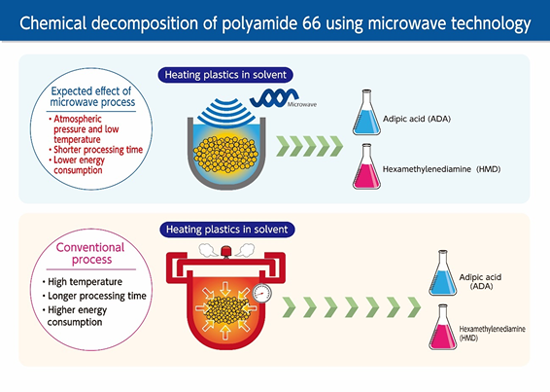Asahi Kasei Corporation and Microwave
Chemical companies have launched a joint demonstration project to commercialize a chemical recycling process for polyamide 66 (PA66, also known as nylon 66) using microwave technology. This process uses microwaves to depolymerize PA66 to directly obtain monomers hexamethylenediamine (HMD) and adipic acid (AA), which is expected to achieve high production capacity and low energy consumption. The monomers obtained can then be used to make new PA66. In a demonstration, PA66 waste from the manufacture of airbags and automotive components was successfully depolymerized.

Asahi Kasei currently produces HMD and AA based on fossil raw materials as intermediates in the manufacture of Leona PA66, Leona
PA66 is an engineering plastic with excellent heat resistance and rigidity. PA66 is used in a variety of applications including: plastic parts for automobiles and electronics, and yarn for airbag fabrics. It is expected that the demand for PA66 will further increase on a global scale.
As the world moves towards carbon neutrality, there is growing interest in manufacturing processes that reduce greenhouse gas (GHG) emissions from fossil-based chemical products. Microwave
Chemical companies are driving technology and business development to achieve carbon neutrality in the industrial sector. The focus is on process development using microwaves. Microwaves can directly and selectively heat target substances with high energy efficiency. In terms of chemical recovery, Microwave
Chemical is advancing its proprietary PlaWave technology platform, which uses microwaves to break down plastics.
Combining Asahi Kasei’s more than half a century of experience in manufacturing HMDs and AAs with Microwave
Chemical’s achievements in the industrialization of microwave technology, the two companies aim to commercialize this manufacturing process for PA66. Compared with traditional manufacturing processes, this process can reduce greenhouse gas emissions.
Laboratory-scale studies beginning in FY2021 have demonstrated the principle that microwaves can be used to depolymerize PA66 in high yields, as well as the isolation and purification process after depolymerization. Before the end of fiscal year 2023, experimental equipment will be in Microwave
Assembled at Chemical’s Osaka plant, the facility will be used in fiscal 2024 to conduct small-scale demonstration tests to collect basic process data needed for commercialization.
Microwave
Chemical’s PlaWave technology platform that uses microwaves to decompose plastics can depolymerize PA66 with low energy and obtain HMD and AA monomers in high yields. Compared with the traditional PA66 manufacturing process, using this technology to depolymerize HMD and AA as raw materials is expected to reduce greenhouse gas emissions, and by using renewable energy to generate the electricity required for microwaves, greenhouse gas emissions can be further reduced.
By comprehensively verifying the process from depolymerization to separation and purification, this demonstration project aims to realize the resource recycling of PA66 to further reduce greenhouse gas emissions.
In the future, based on the results of small-scale demonstration tests, after a detailed analysis, the feasibility of commercialization will be determined by fiscal year 2025. In order to achieve a circular economy with stakeholders in the PA66 value chain, while conducting small-scale demonstration tests, it will also promote the construction of a business model for the entire value chain involving PA66 chemical recycling.
Asahi Kasei aims to be a global partner for its PA66 customers to provide optimal solutions for their carbon neutrality initiatives through research into practical applications of material recovery and chemical recycling, as well as commercial trials of PA66 manufacturing using biomass intermediates.
Microwave
Chemical is working to scale up equipment and adapt the PlaWave platform to a wider range for polymethyl methacrylate (PMMA, also known as acrylic), automotive shredding residue (ASR), plastic containers and packaging, flexible Practical application of chemical recycling of materials such as polyurethane foam.



 微信扫一扫打赏
微信扫一扫打赏
